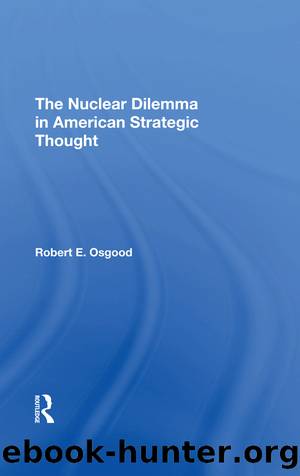The Nuclear Dilemma in American Strategic Thought by Robert Endicott Osgood

Author:Robert Endicott Osgood [Osgood, Robert Endicott]
Language: eng
Format: epub
Tags: Political Science, General
ISBN: 9780813305370
Google: 1B-eDwAAQBAJ
Goodreads: 3200474
Publisher: Westview Press
Published: 1987-12-27T00:00:00+00:00
REAGANâS REVIVAL OF ARMS CONTROL
There were good reasons to think that the Reagan administration, upon assuming office in 1980, would become the champion of the pro-ABM forces. Strongly critical of the strategic arms agreements and coming to power with a mandate to restore U.S. nuclear strength, the administration was the haven and hope for leading maximalists. It came into office deploring the whole process of arms control as previously conducted and resolved not to resume the process until the military balance had been restored and there was evidence of Soviet good behavior in the Third World and elsewhere. Nevertheless, President Reagan soon turned his great popular appeal and political skill toward making arms control the centerpiece of East-West relations. Not only that; by making arms control the instrument of a radical restructuring of deterrence on a nonnuclear basis, he gave it a greatly expanded role, rivaling the role of disarmament in the Baruch Plan and in the subsequent formula of General and Complete Disarmament, which dominated the East-West competition in utopias during the 1950s. Yet, seemingly, he achieved this revival and expansion of arms control with the general approval of the maximalists. Even more remarkable, he prescribed that adherence to the ABM Treaty, not its abrogation or revision, should be the basis for negotiating arms reductions, even though the ultimate objective of such reductions would require the deployment of strategic defense systems prohibited by this treaty, and the function of such systems was a more far-reaching protection of people than ABM advocates had ever imagined.
Reaganâs revival of arms control began when the new administration inherited the position of its predecessor on the deployment of INF missiles in Europe. The United States and its European allies, in accordance with the âtwo-trackâ approach, had already firmly linked INF deployment with arms negotiations ostensibly intended to reach an East-West agreement on the elimination or limitation of deployments, on the assumption that European publics and parliaments would not accept the deployment without the negotiations to avoid it. Inevitably, this approach to the INF issue put the Reagan administration in the position of championing arms control. Moreover, in the course of championing it, as part of the effort to disarm the rising antideployment forces, the administration proved to be a worthy contender for the highest moral ground by means of the most radical proposal. In the famous âzeroâ option, it proposed what was, in effect, a radical disarmament treaty for the elimination of all medium-range missiles in Europe and throughout the world, although it did so with full and well-placed confidence that the Soviets (who, alone, had deployed such missiles) would reject the proposal.
INF negotiations, however, soon became a sideshow after the first Pershing Ils were successfully installed in West Germany in 1984 and the heterogeneous peace movement quickly lost its mobilizing rationale. Then the second wave of Reaganâs revival of arms control came to the forefront: the commitment to deep reductions of strategic nuclear offensive weapons, symbolized by the âRâ in START as the alternative to SALT, which stood condemned for only putting ceilings on existing programs.
Download
This site does not store any files on its server. We only index and link to content provided by other sites. Please contact the content providers to delete copyright contents if any and email us, we'll remove relevant links or contents immediately.
What's Done in Darkness by Kayla Perrin(25500)
Shot Through the Heart: DI Grace Fisher 2 by Isabelle Grey(18219)
Shot Through the Heart by Mercy Celeste(18160)
The Fifty Shades Trilogy & Grey by E L James(17774)
The 3rd Cycle of the Betrayed Series Collection: Extremely Controversial Historical Thrillers (Betrayed Series Boxed set) by McCray Carolyn(13189)
The Subtle Art of Not Giving a F*ck by Mark Manson(12912)
Scorched Earth by Nick Kyme(11832)
Stepbrother Stories 2 - 21 Taboo Story Collection (Brother Sister Stepbrother Stepsister Taboo Pseudo Incest Family Virgin Creampie Pregnant Forced Pregnancy Breeding) by Roxi Harding(11040)
Drei Generationen auf dem Jakobsweg by Stein Pia(10217)
Suna by Ziefle Pia(10186)
Scythe by Neal Shusterman(9259)
International Relations from the Global South; Worlds of Difference; First Edition by Arlene B. Tickner & Karen Smith(8608)
Successful Proposal Strategies for Small Businesses: Using Knowledge Management ot Win Govenment, Private Sector, and International Contracts 3rd Edition by Robert Frey(8419)
This is Going to Hurt by Adam Kay(7695)
Dirty Filthy Fix: A Fixed Trilogy Novella by Laurelin Paige(6453)
He Loves Me...KNOT by RC Boldt(5804)
How to Make Love to a Negro Without Getting Tired by Dany LaFerrière(5378)
Interdimensional Brothel by F4U(5304)
Thankful For Her by Alexa Riley(5161)
